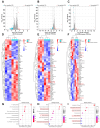Heterologous Expression of Recombinant Ginseng Tetradecapeptide in Saccharomyces cerevisiae and Evaluation of Its Biological Activity
- PMID: 40565658
- PMCID: PMC12191726
- DOI: 10.3390/foods14122049
Heterologous Expression of Recombinant Ginseng Tetradecapeptide in Saccharomyces cerevisiae and Evaluation of Its Biological Activity
Abstract
Ginseng peptides, as bioactive components of ginseng, have attracted increasing attention. In this study, a 14-amino acid ginseng peptide was selected and heterologously expressed in Saccharomyces cerevisiae using a multicopy tandem fusion strategy, named 7RS14α. The secondary structure of the recombinant ginseng tetradecapeptide (7RS14α) was analyzed, and a high-glucose model was established in mouse adipocytes to evaluate its biological activity. Transcriptomic profiling was further performed to elucidate its potential mechanisms. Results demonstrated that 7RS14α significantly enhanced glucose uptake in high-glucose model cells, likely by modulating lipid metabolism pathways and insulin signaling cascades, thereby influencing energy homeostasis in adipocytes.
Keywords: Saccharomyces cerevisiae; diabetes mellitus; ginseng peptides; multicopy tandem expression.
Conflict of interest statement
The authors declare no conflicts of interest.
Figures




Similar articles
-
Umbelliferone attenuates diabetic sarcopenia by modulating mitochondrial quality and the ubiquitin-proteasome system.Phytomedicine. 2025 Aug;144:156930. doi: 10.1016/j.phymed.2025.156930. Epub 2025 May 31. Phytomedicine. 2025. PMID: 40483791
-
[Protective аction of ginseng root extract on myofibril apoptosis and immune response in rats after exhausting physical exercise. Part II. Effect of ginseng root extract on immunity and regulation of energy metabolism].Vopr Pitan. 2025;94(2):61-72. doi: 10.33029/0042-8833-2025-94-2-61-72. Epub 2025 Mar 9. Vopr Pitan. 2025. PMID: 40418135 Russian.
-
Intravenous magnesium sulphate and sotalol for prevention of atrial fibrillation after coronary artery bypass surgery: a systematic review and economic evaluation.Health Technol Assess. 2008 Jun;12(28):iii-iv, ix-95. doi: 10.3310/hta12280. Health Technol Assess. 2008. PMID: 18547499
-
Molecular feature-based classification of retroperitoneal liposarcoma: a prospective cohort study.Elife. 2025 May 23;14:RP100887. doi: 10.7554/eLife.100887. Elife. 2025. PMID: 40407808 Free PMC article.
-
Oral anti-diabetic agents for women with established diabetes/impaired glucose tolerance or previous gestational diabetes planning pregnancy, or pregnant women with pre-existing diabetes.Cochrane Database Syst Rev. 2017 Oct 18;10(10):CD007724. doi: 10.1002/14651858.CD007724.pub3. Cochrane Database Syst Rev. 2017. PMID: 29045765 Free PMC article.
References
-
- Rein M., Ben-Yacov O., Godneva A., Shilo S., Zmora N., Kolobkov D., Cohen-Dolev N., Wolf B.-C., Kosower N., Lotan-Pompan M., et al. Effects of Personalized Diets by Prediction of Glycemic Responses on Glycemic Control and Metabolic Health in Newly Diagnosed T2DM: A Randomized Dietary Intervention Pilot Trial. BMC Med. 2022;20:56. doi: 10.1186/s12916-022-02254-y. - DOI - PMC - PubMed
-
- Zhang C.-L., Yang X., Meng X., Wu L., Liu X., Gao J., Liu S., Wu J., Huang D., Wang Z., et al. Discovery of Novel PTP1B Inhibitors with Once—Weekly Therapeutic Potential for Type 2 Diabetes: Design, Synthesis, and In Vitro and In Vivo Investigations of BimBH3 Peptide Analogues. J. Med. Chem. 2023;66:3030–3044. doi: 10.1021/acs.jmedchem.2c02003. - DOI - PubMed
-
- Naufel M.F., Telles M.M., Hachul A.C.L., Santamarina A.B., Oyama L.M., Coelho F.M.S., Ribeiro E.B., Pedroso A.P. Bioactive Natural Products for the Prevention and Treatment of Diabetes Mellitus. Stud. Nat. Prod. Chem. 2020;67:161–197. doi: 10.1016/B978-0-12-819483-6.00005-9. - DOI
Grants and funding
LinkOut - more resources
Full Text Sources

